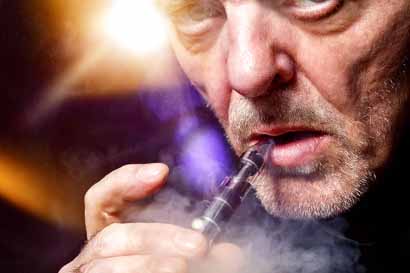Public Health England (PHE) has released a new film showing the devastating harms that can be caused by smoking combustible cigarettes, and how those health problems can be avoided by switching to vaping electronic cigarettes or by using a quit aid.
The film has been released as part of PHE’s Health Harms campaign, which encourages smokers to attempt to quit in January. It demonstrates the harm to health caused by every cigarette.
The film features a leading smoking cessation academic at University College London, Dr. Lion Shahab, and a National Health Service GP, Dr. Rosemary Leonard, ‘visually demonstrating the high levels of cancer-causing chemicals and tar inhaled by an average smoker over a month, compared to not smoking or using an e-cigarette,’ according to a PHE press note on the GOV.UK website.
‘The results of the demonstration visually illustrate the stark contrast between the impacts of smoking and vaping. Research estimates that while not risk-free, vaping is at least 95 percent less harmful than smoking.
‘Around 2.5 million adults are using e-cigarettes in England, and they have helped thousands of people successfully quit – but many smokers (44 percent) either believe that vaping is as harmful as smoking (22 percent) or don’t know that vaping poses much lower risks to health (22 percent).’
Professor John Newton, director of health improvement at PHE, was quoted as saying that it would be tragic if thousands of smokers who could quit with the help of an e-cigarette were being put off due to false fears about safety. “We need to reassure smokers that switching to an e-cigarette would be much less harmful than smoking,” he said. “This demonstration highlights the devastating harms caused by every cigarette and helps people see that vaping is likely to pose only a fraction of the risk.
“We want to encourage more smokers to try and quit completely with the help of an e-cigarette, or by using other nicotine replacement such as patches or gum, as this will significantly improve their chances of success. If you’re trying to stop smoking, our free online personal quit plan will help you find the support that’s right for you.”
Meanwhile, Shahab was quoted as saying that the false belief that vaping was as harmful as smoking could be preventing thousands of smokers from switching to e-cigarettes to help them quit. “I hope this illustrative experiment helps people see the huge damage caused by smoking that could be avoided by switching to an e-cigarette,” he said.
“Research we and others have conducted shows that vaping is much less harmful than smoking and that using e-cigarettes on a long-term basis is relatively safe, similar to using licensed nicotine products, like nicotine patches or gum. Using e-cigarettes or nicotine replacement such as patches or gum will boost your chances of quitting successfully.
“Smoking increases the risk of developing more than 50 serious health conditions, including cancer and heart disease, and doubles the risk of dying from a stroke. Of the 6.1 million smokers in England, 6 in 10 want to quit, but many try to quit using willpower alone – or going ‘cold turkey’ – despite this being the least effective method.
“The most successful quit attempts use a combination of effective stop smoking support methods. Recent research suggests that smokers who quit with the help of an e-cigarette are less likely to start smoking again.
“Public Health England’s personal quit plan is a quick, free and easy-to-use digital tool to help smokers find the right support to help them quit, taking into account how much they smoke, and any quitting support used previously.”
Leonard said that she had wanted to be involved in the experiment because every day she saw the devastating impact that smoking had on people’s health, but rarely got the opportunity to show people what was happening inside their bodies when they smoked.
“I regularly give patients advice about quitting and when I recommend e-cigarettes, I am often surprised to hear the misconceptions some people have about them, she said. “The results of this experiment clearly show that every cigarette you smoke causes tar to enter your body and spreads poison throughout your bloodstream. Vaping is much less harmful than smoking and I really hope this experiment will encourage smokers to make a quit attempt. No matter how old you are, it’s never too late to stop.”
John Dunne MD of E-Liquid Brands and director of the UK Vaping Industry Association (UKVIA) described the contents of the PHE press note as “fantastic news going into the new year when many people in this country are looking to quit smoking and improve their health”. “This further goes to support the positive vaping narrative that this country is lucky to have and I hope it will assist smokers in making an informed decision,” he said.
“Vaping is fast becoming the most popular quitting aid in the UK and around the world. However, according to the latest ASH research 40 percent of smokers have not tried them. There is a serious public misunderstanding of the risks and benefits of e-cigarette use.
“Millions of smokers wrongly think that vaping is as harmful as smoking and fewer than one in ten adults know that most of the health damage caused by smoking comes from the by-products of cigarette combustion, and not from the nicotine content. In 2017 only 13 percent of adults correctly identified that e-cigarettes are much less harmful than smoking, compared to 21 percent in 2013. The proportion of adults thinking that e-cigarettes are at least as dangerous as smoking nearly quadrupled from 2013 to 2017 from seven percent to 26 percent.
“I hope that this experiment will go some way to dispelling this false notion.”










